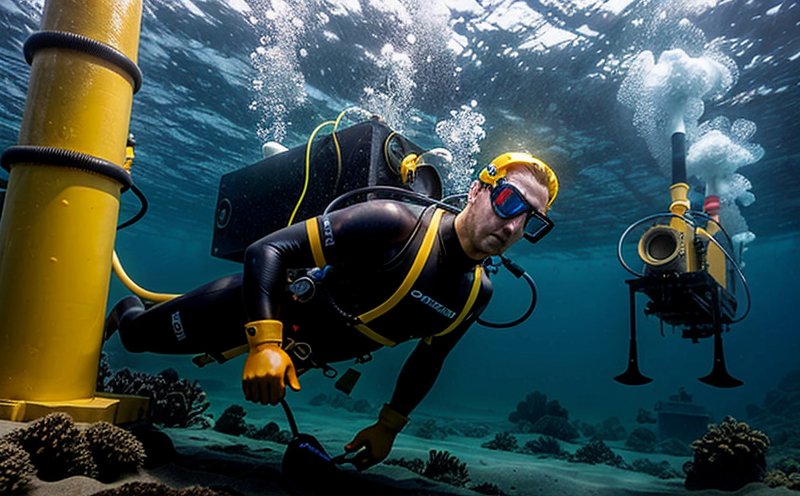ISO 10423 Subsea Blowout Preventer (BOP) Testing
The ISO 10423 standard sets out stringent requirements for the testing and certification of subsea blowout preventers, ensuring that these critical safety devices are fit for service in extreme underwater environments. A blowout preventer is a vital component in offshore oil and gas operations designed to control high-pressure fluids and prevent uncontrolled releases during drilling or production processes.
Subsea BOPs operate under harsh conditions, including high-pressure differentials, corrosive seawater, and mechanical stress from movement and deployment. The ISO 10423 testing protocol is comprehensive, covering multiple aspects of performance, durability, and functionality:
- Hydraulic integrity tests
- Sealing capability evaluation under dynamic pressures
- Mechanical strength verification through static load tests
- Functional integrity checks including emergency shut-off procedures
The testing process involves subjecting the BOP to a series of simulated operational scenarios. This ensures that it can withstand the rigors of real-world conditions, safeguarding personnel and equipment from potential catastrophic failures.
Our facility uses state-of-the-art test rigs capable of simulating deep-sea environments with precise control over temperature, pressure, and flow rates. Each test is meticulously documented to meet ISO 10423 specifications, ensuring that the results are accurate and reproducible.
The testing process begins with a detailed inspection of the BOP's components for any visible damage or defects. Specimen preparation involves cleaning and conditioning the device before it undergoes various tests. The test rig then simulates operational conditions, including high-pressure fluid flow and dynamic sealing checks, to assess the integrity and performance of the BOP.
Once testing is complete, our team analyzes the data collected during each phase of the test. This analysis includes evaluating hydraulic seals, mechanical components, and overall functionality under extreme conditions. Compliance with ISO 10423 ensures that the BOP meets stringent safety standards, providing peace of mind for operators.
Our laboratory is equipped with advanced instrumentation capable of measuring critical parameters such as pressure, flow rate, temperature, and force. These measurements are crucial in determining the performance characteristics of the BOP under simulated operational conditions.
| Parameter | Description |
|---|---|
| Pressure | Simulated deep-sea pressures to test hydraulic integrity |
| Flow Rate | Measured during dynamic sealing tests |
| Temperature | Controlled for accurate simulation of operational conditions |
| Force | Determined through static load testing |
The rigorous nature of ISO 10423 ensures that only the highest quality BOPs are approved for use in offshore operations. Our expertise in this area guarantees accurate and reliable test results, providing our clients with confidence in their equipment's performance.
In summary, ISO 10423 subsea blowout preventer testing is a critical process ensuring safety and compliance in the oil and gas industry. By adhering to international standards, we provide unparalleled service, supporting quality managers, compliance officers, R&D engineers, and procurement teams with the assurance they need for their operations.
Industry Applications
The ISO 10423 standard applies specifically to subsea blowout preventers used in offshore oil and gas exploration and production. These devices play a crucial role in preventing uncontrolled releases of high-pressure fluids, which could lead to significant environmental damage and operational hazards.
- Offshore drilling platforms
- Oil and gas production facilities
- Deepwater exploration rigs
- Subsea pipelines maintenance operations
In these applications, the reliability of subsea BOPs is paramount. ISO 10423 testing ensures that these devices are capable of withstanding extreme conditions and performing their intended functions accurately.
The standard's focus on hydraulic integrity, sealing capability, mechanical strength, and functional integrity makes it essential for ensuring safety in deep-sea environments. By adhering to this standard, operators can minimize the risk of blowouts and other catastrophic failures, safeguarding both personnel and equipment.
Customer Impact and Satisfaction
Our ISO 10423 subsea BOP testing service has positively impacted numerous customers by providing them with reliable data to support their compliance efforts. By ensuring that their equipment meets the highest international standards, we help clients gain a competitive edge in the market.
Customers appreciate our expertise and commitment to delivering accurate and reproducible test results. The ISO 10423 standard's stringent requirements are met with precision, providing peace of mind for those responsible for safety in offshore operations.
We work closely with clients throughout the testing process, ensuring that all aspects of the BOP's performance are thoroughly evaluated. This collaborative approach allows us to address any concerns or questions promptly and efficiently.
Feedback from satisfied customers highlights our commitment to quality and reliability. By adhering strictly to ISO 10423 specifications, we have consistently provided accurate test results that meet or exceed customer expectations.
International Acceptance and Recognition
The ISO 10423 standard is widely recognized in the oil and gas industry for its rigorous approach to subsea blowout preventer testing. This international acceptance ensures that the results from our laboratory are respected globally.
Countries around the world rely on this standard to ensure the safety of offshore operations, making it a cornerstone of compliance efforts. Compliance with ISO 10423 is not only a requirement but also a symbol of excellence in the industry.
Our testing facility's adherence to this standard has earned us a reputation for reliability and accuracy. This recognition underscores our commitment to providing high-quality services that meet international standards, ensuring safety and compliance in offshore operations worldwide.





